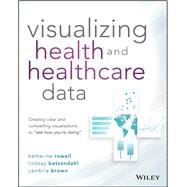The only data visualization book written by and for health and healthcare professionals.
In health and healthcare, data and information are coming at organizations faster than they can consume and interpret it. Health providers, payers, public health departments, researchers, and health information technology groups know the ability to analyze and communicate this vast array of data in a clear and compelling manner is paramount to success. However, they simply cannot find experienced people with the necessary qualifications. The quickest (and often the only) route to meeting this challenge is to hire smart people and train them.
Visualizing Health and Healthcare Data: Creating Clear and Compelling Visualizations to "See how You're Doing" is a one-of-a-kind book for health and healthcare professionals to learn the best practices of data visualization specific to their field. It provides a high-level summary of health and healthcare data, an overview of relevant visual intelligence research, strategies and techniques to gather requirements, and how to build strong teams with the expertise required to create dashboards and reports that people love to use. Clear and detailed explanations of data visualization best practices will help you understand the how and the why.
- Learn how to build beautiful and useful data products that deliver powerful insights for the end user
- Follow along with examples of data visualization best practices, including table and graph design for health and healthcare data
- Learn the difference between dashboards, reports, multidimensional exploratory displays and infographics (and why it matters)
- Avoid common mistakes in data visualization by learning why they do not work and better ways to display the data
Written by a top leader in the field of health and healthcare data visualization, this book is an excellent resource for top management in healthcare, as well as entry-level to experienced data analysts in any health-related organization.








